Injury is a major, preventable public health problem in terms of morbidity, premature mortality or disability. Worldwide, the projections for 2020 show that 8.4 million deaths are expected annually. Trauma has its own natural history and it follows the same epidemic pattern as any other disease, that is, agent, host and environment interacting together to produce injury or damage. The mortality and economic losses imposed by morbidity which results from injuries are largely preventable. However, the development of effective injury prevention efforts depends on reliable and detailed information on the incidence and pattern of injury. Injury, as a research problem, has also been largely ignored in developing countries. An examination of ‘years of potential life lost’ indicated that injuries were the second most common cause of death after 5 years of age in India. Injury is thus, a long-overlooked health problem that deserves study. This study was conducted to understand and describe the incidence and pattern, cause and mode of injuries in Dakshina Kannada District, Karnataka, India.
Materials and Methods
Study conducted in emergency department of a tertiary care center in Mangalore (India), during the period from January 2013 to August 2013. The data was collected by purposive sampling technique. The study group-consisted of 1,140 trauma victims who were admitted to the hospital in this period. Inclusion criteria were injured patients of any ages, who presented to the casualty department. A pretested trauma registry form was completed for all trauma patients, which included informed consent. Basic demographic characteristics, time and date, nature and cause of injury, vital signs and outcome data were recorded. In case of road traffic injuries, types of vehicles and modes of collisions were recorded. A thorough clinical examination and necessary investigations were done. The collected data was entered in Microsoft Excel and analyzed.
Results
[Table/Fig-1,2,3,4,5,6,7,8,9and10]
Distribution of cases related to trauma
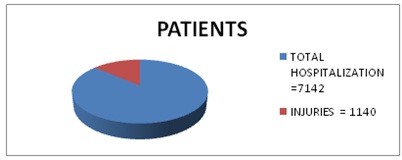
Age distribution of cases
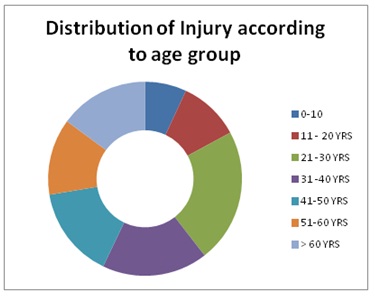
Discussion
The main challenge for public health in the coming century is to decrease the burden of injuries. Accelerated urbanization and industrialization, over the past three decades, has led to an alarming increase in the rates of accidental injuries, crime and violence in India.
In the present study, we found that annual incidence of trauma admissions in our hospital was 15.96%. Most of the injuries were seen in 21-40 years age group (39.67 %).Similar findings were noted in a study which was done by Swarnkar M and co associates in a hospital in central India [1]. This age group is the most productive age group, and trauma and its morbidity result in a huge economic setback for the country. Males far outnumbered females, with a ratio of 2.3:1. Similarly, a male predominance was seen in other studies which were done in India [1–3], which could have occurred due to the fact that in India, males are still the main working community and are hence more exposed to work related stress and workplace injuries.
In our study, the incidence of limb injuries was more (66.92%), which was in contrast to head injuries, they being the most common injuries seen in other parts of the country [1,4]. A majority of cases were admitted during evening to midnight (61.24%), which is also observed by other authors [1] Twilight condition, with increased fatigue and decreased alertness, leads to increased trauma.
An unprecedented increase in the number of vehicles has outpaced the development of adequate roads and highways. India has 1% of the motor vehicles in the world, but it bears the burden of 6% of the global vehicular accidents [5]. According to the World Health Organization (WHO), road traffic injuries are the sixth leading cause of death in India, with a greater share of hospitalization, deaths, disabilities and socio-economic losses in the young and middle-aged populations [2]. We had 191 cases of road traffic accidents, out of which 76 cases were pedestrian injuries. In data from Delhi, India, pedestrian injuries accounted for 41% of the injuries [4].RTAs accounted for the second common mode of trauma seen following fall in our study, which was in contrast to those seen in other studies, where RTAs were the most common mode of injury [1,3].
Fall from height was the commonest mode of injury (60.78%). Similar results were found in other studies as well [1]. Assault with blunt objects (58.6%) was most common than assault with sharp objects. Alcohol intoxication was seen in 6.14 % of the patients.
Highest numbers of deaths were seen following head injuries (66.7%), which was similar to that seen in other studies [1,2,5].
In a developing country like India, which is already wriggling under the enormous burden of infectious and tropical diseases and the regular outbreaks of epidemics, we should make all efforts to reduce this burden and not add to it. The industrial growth and might of our country was never so envied as it is today and with this, lot of social and structural changes are evident around us. All of this have led to lifestyle modifications and social ethics, as a result of which there has been this surge in trauma related hospital admissions across the country. We have made an effort to collect this data, analyze and present it to highlight trauma related issues and their trends. This is a brief study which throws some light on this preventable cause of morbidity and the need to bring about some changes in effective governance, to check this menace [Table/Fig-2–10].
Distribution of commonly affected body parts
| Sl No | Injury Area | | | | | | |
|---|
| Male | % | Female | % | Total | % |
|---|
| 1 | Head & Neck injury | 200 | 25.12 | 85 | 24.7 | 285 | 25 |
| 2 | Abdominal Injury | 45 | 5.65 | 29 | 8.43 | 74 | 6.49 |
| 3 | Thoracic Injury | 13 | 1.63 | 5 | 1.45 | 18 | 1.57 |
| 4 | Limb | 538 | 67.58 | 225 | 65.40 | 763 | 66.92 |
| Total | 796 | 100 | 344 | 100 | 1140 | 100 |
Distribution of population/ samples according to sex
| S.No | Gender | Frequency | Percentage |
|---|
| 1 | Female | 344 | 30.2 |
| 2 | Male | 796 | 69.8 |
| Total | 1140 | 100 |
Cause of injuries patterns as seen in different types of injuries
| S.No | Cause | Male | Female | Number | Percentage |
|---|
| 1 | R.T.A* | 147 | 44 | 191 | 16.75% |
| 2 | Fall | 559 | 134 | 693 | 60.78% |
| 3 | Assault | 93 | 40 | 133 | 11.6% |
| 4 | Miscellaneous | 30 | 23 | 53 | 4.64% |
| 5 | Alcohol | 49 | 21 | 70 | 6.14% |
| Total | 878 | 262 | 1140 | 100 |
*RTA : Road traffic accident
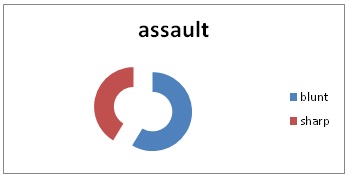
| Fall from tree | 223 | 32.8% |
| Fall from roof | 169 | 24.3% |
| Fall from bed | 36 | 5.19?% |
| Fall on ground | 256 | 36.94% |
| Fall from stairs | 9 | 1.29% |
Type of RTA
RTA: Road traffic accident
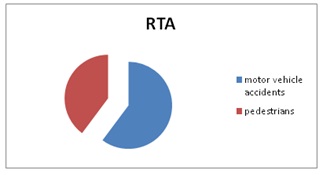
| Timing | Frequency | Percentage |
|---|
| Morning/Day time | 436 | 37.93 |
| Evening/Night time | 704 | 61.24 |
| Total | 1140 | 100 |
Mortality associated with various injuries
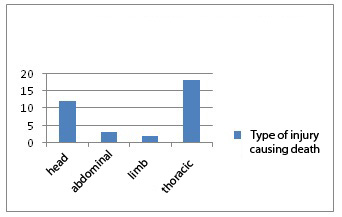
Conclusion
Trauma in India is a significant social and financial burden, which requires prioritized attention. An effort has been made to highlight the morbidity and mortality which are associated with fall and RTAs in this region and the data analysis shows patterns of injuries which were sustained, which involved limb, head and neck. Also, the presence of alcohol intoxication underlies the urgent need for necessary protective and preventive measures to be taken, for the benefit of the community.
*RTA : Road traffic accident